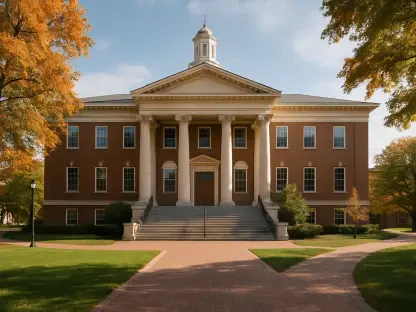In a state renowned for its rugged landscapes and close-knit communities, Idaho is confronting an unexpected challenge that has caught the attention of educators and policymakers alike: a persistent decline in K-12 public school enrollment. For the fall of the 2025-26 school year, data from the Idaho State Board of Education shows a statewide drop of 3,042 students, equating to a 1% decrease, with total enrollment now at 310,299. This downturn, potentially marking a second consecutive year of decline, signifies a notable shift from the post-COVID-19 recovery trends of recent years. While traditional public school districts bear the brunt of this loss, shedding 3,280 students (a 1.2% drop to 268,282), public charter schools have seen a slight increase of 319 students (0.8% growth to 42,017). This divergence raises urgent questions about changing parental preferences, demographic realities, and the evolving role of public education in Idaho. Beyond the raw numbers, deeper forces—ranging from economic pressures to policy innovations—are reshaping the educational landscape, demanding a closer examination of what’s driving these trends.
Unpacking the Demographic Pressures
Falling Birth Rates and Shifting Migration
The root of Idaho’s enrollment decline lies in demographic shifts that mirror national patterns, particularly a sustained drop in birth rates over recent years. Fewer births result in a smaller pool of school-aged children, directly reducing the number of students entering kindergarten annually. Compounding this issue is the state’s migration dynamics, which have brought an influx of new residents, many of whom do not have children in the K-12 age range. This creates a demographic mismatch, where population growth does not lead to increased school enrollment. State Superintendent Debbie Critchfield has emphasized how these factors create a ripple effect, with smaller incoming classes setting the stage for lower numbers in subsequent grades. The long-term implications of this shift could force school districts to adapt their resources and planning to a shrinking student base, even as the state’s overall population grows.
Another layer to this demographic puzzle is the post-pandemic behavior of families, with some choosing to delay kindergarten enrollment for their children. Often driven by health concerns or a preference for alternative early education options, this delay means some students reappear in later grades, such as middle school. While this offers potential for future enrollment rebounds, the uncertainty around timing and scale complicates district budgeting and staffing decisions. Additionally, the declining birth rate is not unique to Idaho but part of a broader national trend that has seen public school numbers dwindle across many states. Understanding these patterns as interconnected with larger societal changes is crucial for crafting policies that address the root causes rather than merely the symptoms of enrollment decline.
Economic Barriers and Housing Challenges
Economic pressures, particularly the sharp rise in housing costs, are another key factor pushing young families away from Idaho or preventing them from settling in the state. As home prices and rents soar, affordability becomes a barrier for those with school-aged children, leading to smaller incoming cohorts in many districts. This financial strain often forces families to relocate to more affordable areas outside Idaho, further depleting the student population in local schools. Rural areas, already struggling with limited economic opportunities, feel this impact acutely, as do urban centers where housing demand drives costs out of reach for many. The result is a direct hit to enrollment, especially in districts reliant on steady family growth to maintain their numbers.
Beyond housing, the broader economic climate affects family dynamics in ways that ripple through the education system. For instance, job market fluctuations and the cost of living can influence decisions about family size or whether to enroll children in public schools versus other options. In some cases, families may prioritize immediate financial stability over long-term educational plans, opting for homeschooling or alternatives that reduce costs or align with work schedules. This economic backdrop, combined with demographic trends, paints a complex picture of why traditional public school enrollment continues to slide. Addressing these challenges requires not just educational reform but also broader policy interventions to support family-friendly economic conditions in Idaho.
Policy Changes and Educational Choices
Rising Appeal of Charter Schools
Amid the decline in traditional public school numbers, charter schools in Idaho are experiencing a modest but notable upswing, with a 0.8% enrollment increase to 42,017 students in the 2025-26 fall term. This growth reflects growing parental demand for diverse educational models within the public system, often driven by perceptions of flexibility, specialized curricula, or smaller class sizes. Specific charter programs have seen remarkable gains, such as Pathways In Education in West Ada, which reported a striking 264.2% increase, adding 140 students. These success stories suggest that charters are filling a niche for families seeking alternatives without leaving the public education framework. Superintendent Critchfield views this trend as evidence of the system’s adaptability, emphasizing that public education remains a valued choice, even if in varied forms.
However, the charter school boom is not uniform, as individual outcomes vary widely based on location, program quality, and community demand. While some charters thrive, others, like Pinecrest Academy of Lewiston, saw a sharp 36.4% decline, losing 59 students. This variability underscores the competitive nature of educational choice, where charters must continually prove their worth to attract and retain students. The growth in charter enrollment also raises questions about resource allocation, as traditional districts losing students may face budget cuts while charters require funding to expand. Balancing these dynamics is a key challenge for state policymakers, who must ensure equity in access and quality across all public education options while addressing the underlying reasons families are turning away from traditional schools.
Influence of Private and Homeschooling Incentives
Recent policy shifts in Idaho are also reshaping the educational landscape, with new state-funded initiatives providing alternatives to traditional public schooling. A notable example is a $50 million tax credit program introduced to support private school tuition and homeschooling expenses, potentially diverting students from public districts. Although precise data on private and homeschool enrollment remains elusive, estimates from the Idaho State Board of Education suggest nearly 18,000 students are in private schools alone. This growing availability of non-public options reflects a broader trend of empowering parental choice, but it also raises concerns about the impact on traditional school funding and community cohesion, as resources and students are spread across more educational pathways.
The appeal of private and homeschool options often ties into family values, financial considerations, or dissatisfaction with aspects of public schooling, especially following pandemic-related disruptions. For some, these alternatives offer tailored learning environments or greater control over curriculum and schedules. Yet, this shift poses a dilemma for public education advocates, who worry about the long-term effects of reduced enrollment on school programs, teacher retention, and infrastructure maintenance. As these policy changes take hold, monitoring their impact on enrollment distribution becomes essential. The challenge lies in striking a balance between supporting diverse educational choices and ensuring that traditional public schools remain robust and accessible to all families who rely on them.
Regional Disparities in Enrollment Patterns
Struggles of Major School Districts
Across Idaho, the largest school districts are grappling with significant enrollment declines, underscoring the scale of the challenge facing traditional public education. Eight of the state’s ten biggest districts reported losses in the fall of 2025-26, with Boise seeing a 2.2% drop (475 students), Nampa a 2.6% decrease (331 students), and Twin Falls a 2.8% decline (252 students). These numbers highlight a widespread issue among urban and suburban districts, where population density once guaranteed steady enrollment but now reveals vulnerabilities tied to demographic and economic shifts. The loss of students in these key areas often translates into reduced funding, which can strain resources for essential programs and staff, creating a vicious cycle of cutbacks and further dissatisfaction among families.
The struggles of major districts also reflect broader societal trends, such as the movement of families to more affordable regions or the appeal of alternative schooling options. In places like Boise, where housing costs have surged, young families may find it increasingly difficult to stay, directly impacting school numbers. Additionally, large districts often face bureaucratic challenges that can hinder quick adaptation to changing needs, making it harder to compete with more agile charter or private options. Addressing these declines requires targeted strategies, such as community engagement initiatives or partnerships with local governments to tackle housing affordability, alongside efforts to enhance the appeal of public schools through innovative programming and improved facilities.
Pockets of Growth in Smaller Areas
In contrast to the struggles of larger districts, some smaller school districts and charter schools in Idaho are experiencing surprising growth, pointing to a redistribution of students rather than a universal decline. Vallivue, for instance, saw a 3.3% increase, adding 336 students, while rural Avery reported a staggering 210% jump, albeit from a small base of 10 to 31 students. Such gains in less populated areas suggest that families may be seeking out communities with lower costs of living or more personalized educational environments. This trend also indicates that smaller districts might be better positioned to adapt to local needs, offering a sense of community that resonates with parents disillusioned by larger, more impersonal systems.
Charter schools in smaller regions or niche markets are also contributing to this pattern of growth, with some programs seeing significant enrollment boosts by catering to specific educational philosophies or student needs. However, the dramatic percentage increases in tiny districts like Avery can be misleading, as small absolute changes appear outsized due to low baseline numbers. Nevertheless, these pockets of growth offer valuable lessons for larger districts on the importance of flexibility and community connection. Policymakers and educators might consider how to replicate these successes on a broader scale, ensuring that growth in smaller areas does not come at the expense of equitable resource distribution across the state. The varied regional outcomes underscore the complexity of enrollment trends and the need for localized solutions.
Reflecting on Future Pathways
Looking back, the decline in Idaho’s K-12 public school enrollment during the 2025-26 fall term revealed a multifaceted issue shaped by demographic downturns, economic hurdles, and policy innovations. The 1% statewide drop, driven largely by losses in traditional districts, stood in contrast to modest gains in charter schools, painting a picture of an education system in flux. Superintendent Critchfield’s perspective provided a balanced outlook, acknowledging the challenges while pointing to the resilience of public education through its evolving forms. Moving forward, actionable steps could include targeted investments in affordable housing to retain young families, alongside efforts to enhance public school offerings to compete with growing alternatives. Additionally, refining data collection on private and homeschool trends would offer clearer insights for planning. By adapting to these shifting dynamics with innovative strategies and a commitment to equity, Idaho’s public education system can navigate this transition, ensuring it meets the diverse needs of future generations.









